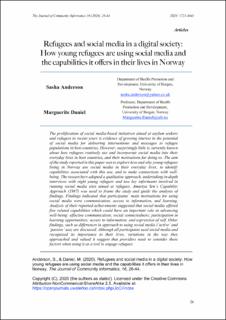Refugees and social media in a digital society: how young refugees are using social media and the capabilities it offers in their lives in Norway
Journal article, Peer reviewed
Published version

Åpne
Permanent lenke
https://hdl.handle.net/11250/2766924Utgivelsesdato
2020Metadata
Vis full innførselSamlinger
Originalversjon
Journal of Community Informatics. 2020, 16, 26-44. https://doi.org/10.15353/joci.v16i0.3473Sammendrag
The proliferation of social media-based initiatives aimed at asylum seekers and refugees in recent years is evidence of growing interest in the potential of social media for delivering interventions and messages to refugee populations in host countries. However, surprisingly little is currently known about how refugees routinely use and incorporate social media into their everyday lives in host countries, and their motivations for doing so. The aim of the study reported in this paper was to explore how and why young refugees living in Norway use social media in their everyday lives, to identify capabilities associated with this use, and to make connections with well- being. The researchers adopted a qualitative approach, undertaking in-depth interviews with eight young refugees and two key informants involved in running social media sites aimed at refugees. Amartya Sen’s Capability Approach (1987) was used to frame the study and guide the analysis of findings. Findings indicated that participants’ main motivations for using social media were communication, access to information, and learning. Analysis of their reported achievements suggested that social media offered five related capabilities which could have an important role in advancing well-being: effective communication; social connectedness; participation in learning opportunities; access to information; and expression of self. Other findings, such as differences in approach to using social media (‘active’ and ‘passive’ use) are discussed. Although all participants used social media and recognised its importance to their lives, variations in the way they approached and valued it suggest that providers need to consider these factors when using it as a tool to engage refugees.
